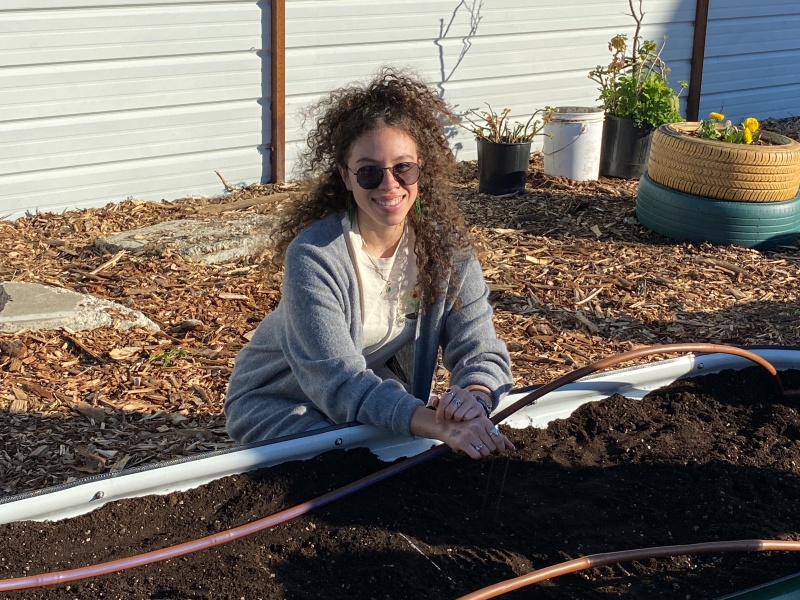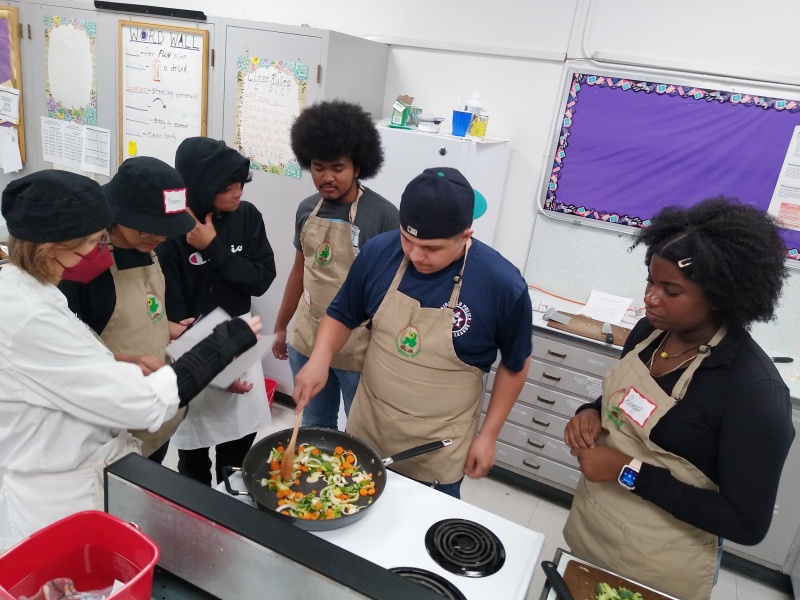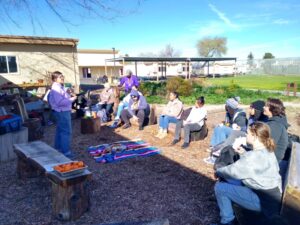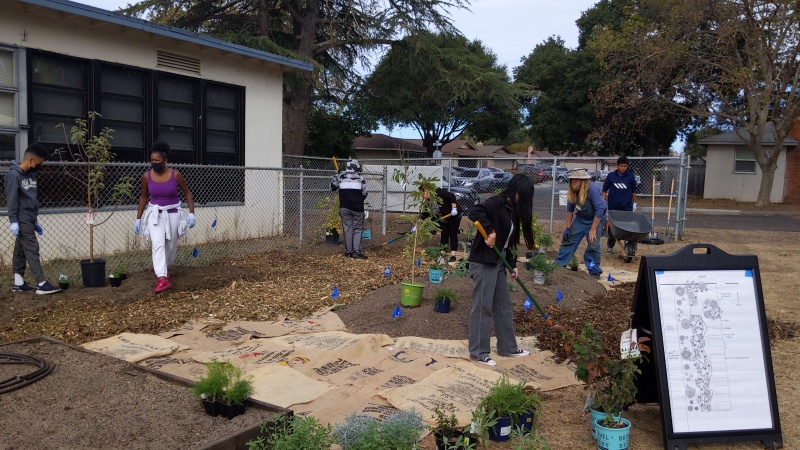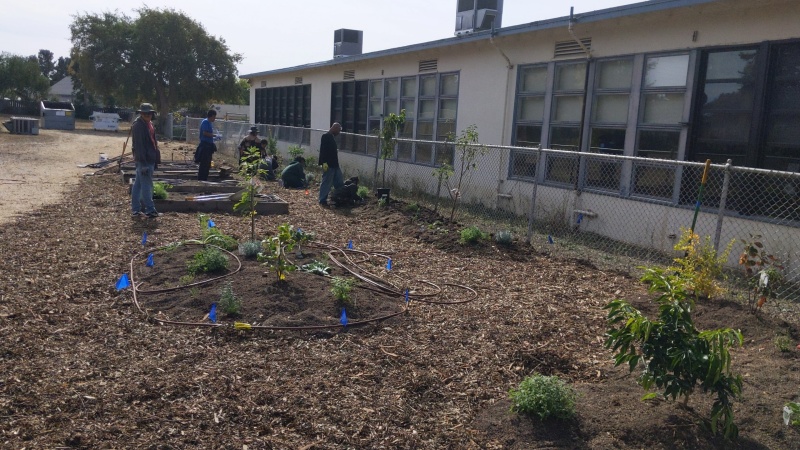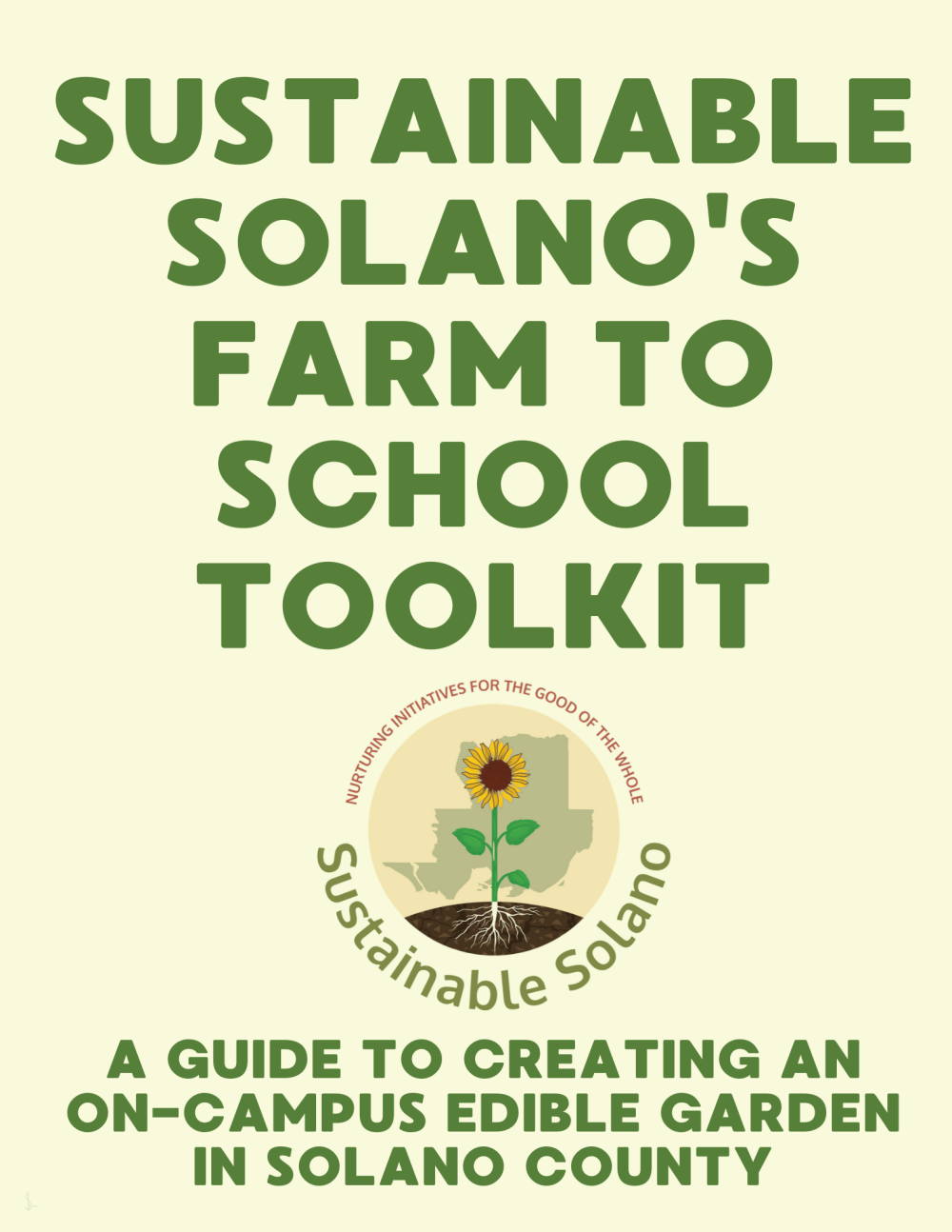2023 Benicia & Vallejo Tour: Featured Gardens
The Curious Garden
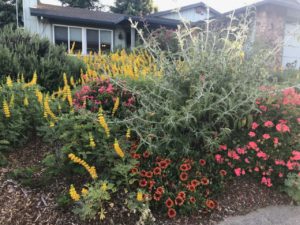 Mature front yard food forest has mostly fruit trees and native plants that attract pollinators year-round. It has a laundry-to-landscape greywater system.
Mature front yard food forest has mostly fruit trees and native plants that attract pollinators year-round. It has a laundry-to-landscape greywater system.
The garden is designed for a young family, including space to enjoy the outdoors and hidden forts. It also has a very steep hill, which presents its own unique issues.
Greywater Action’s Andrea Lara will be giving a talk and tour of the laundry-to-landscape system at 11 am and 12 pm.
Greyhawk Grove
 An 8-year-old established food forest with two swales that are dug out and refreshed every 2-3 years, laundry-to-landscape greywater to fruit trees, and chickens. The drip irrigation system was removed three years ago and the garden is thriving! Annual beds are hand-watered once a week during the growing season. Greyhawk Grove is a “high-traffic-survival-of-the-fittest-have-three-young-children garden”. There may be lemonade and baked goods for sale by children, as well as products from the garden to give away (dried calendula, lavender, herbs, eggs, fruit, etc.).
An 8-year-old established food forest with two swales that are dug out and refreshed every 2-3 years, laundry-to-landscape greywater to fruit trees, and chickens. The drip irrigation system was removed three years ago and the garden is thriving! Annual beds are hand-watered once a week during the growing season. Greyhawk Grove is a “high-traffic-survival-of-the-fittest-have-three-young-children garden”. There may be lemonade and baked goods for sale by children, as well as products from the garden to give away (dried calendula, lavender, herbs, eggs, fruit, etc.).
Redwood Guild
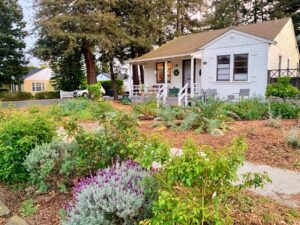 Food forest garden and greywater system installed as part of Sustainable Solano’s 2021 Permaculture Design Certificate course, with students transforming the front lawn with rain-capturing swales and planted berms and converting the sprinkler system to drip irrigation. The side yard is watered by a laundry-to-landscape greywater system and also includes edible plants and native pollinators. This home has its own redwood grove, and certain plants were selected that do well in the unique conditions created by redwoods. The food forest keepers are using that knowledge to add other plants to the garden that will thrive alongside the redwoods.
Food forest garden and greywater system installed as part of Sustainable Solano’s 2021 Permaculture Design Certificate course, with students transforming the front lawn with rain-capturing swales and planted berms and converting the sprinkler system to drip irrigation. The side yard is watered by a laundry-to-landscape greywater system and also includes edible plants and native pollinators. This home has its own redwood grove, and certain plants were selected that do well in the unique conditions created by redwoods. The food forest keepers are using that knowledge to add other plants to the garden that will thrive alongside the redwoods.
Designer Scott Dodson of Scotty’s Organic Gardening will be on-site to guide tours, describe the permaculture principles and offer advice.
Wild Cherry Way
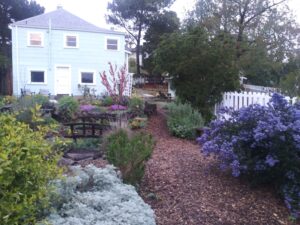 Southern slope food forest focused on pollinators, shrubs and native plants. It also includes fruit trees, perennial and edible plants, swales and a laundry-to-landscape greywater system.
Southern slope food forest focused on pollinators, shrubs and native plants. It also includes fruit trees, perennial and edible plants, swales and a laundry-to-landscape greywater system.
Permaculture Consultant Ron Kane will be on-site to offer tours and answer questions.
Yggdrasil Garden
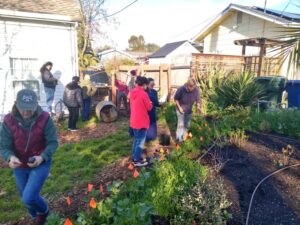 A new and evolving food forest garden and greywater system installed as part of Sustainable Solano’s 2022-23 Permaculture Design Certificate course. Students transformed the front yard with a rain-capturing swale and planted berms in holistic workshops. The east side yard (in development) is watered with both a rain-capturing swale and a laundry-to-landscape system and will have an aquatic garden and feature scented contributions to the edible landscape. The west side yard raised bed and climbing vines are watered by a laundry-to-landscape greywater system and include edible plants and native pollinators. The monarch butterfly-hosting back gardens were supported by a Sustainable Solano irrigation class and are watered by both a rain-capturing swale and greywater and nurtured by specially prepared compost on-site. A rear patio and herb spiral (in construction) were created with bricks repurposed from the chimney of the circa 1850s historic home, retaining walls from pieces of historic on-site stables. Displays feature the historic aspects of the home; its background and ongoing tradition of art, design, and healing; soil cultivation with worm habitats; information about the Ohlone Sogorea Te Indigenous Land Trust and rematriation of Carquin land; the influence of the garden’s stewards; and the garden’s first tree guilds: yuzu persimmon, apricot, and meyer lemon.
A new and evolving food forest garden and greywater system installed as part of Sustainable Solano’s 2022-23 Permaculture Design Certificate course. Students transformed the front yard with a rain-capturing swale and planted berms in holistic workshops. The east side yard (in development) is watered with both a rain-capturing swale and a laundry-to-landscape system and will have an aquatic garden and feature scented contributions to the edible landscape. The west side yard raised bed and climbing vines are watered by a laundry-to-landscape greywater system and include edible plants and native pollinators. The monarch butterfly-hosting back gardens were supported by a Sustainable Solano irrigation class and are watered by both a rain-capturing swale and greywater and nurtured by specially prepared compost on-site. A rear patio and herb spiral (in construction) were created with bricks repurposed from the chimney of the circa 1850s historic home, retaining walls from pieces of historic on-site stables. Displays feature the historic aspects of the home; its background and ongoing tradition of art, design, and healing; soil cultivation with worm habitats; information about the Ohlone Sogorea Te Indigenous Land Trust and rematriation of Carquin land; the influence of the garden’s stewards; and the garden’s first tree guilds: yuzu persimmon, apricot, and meyer lemon.
Michael Wedgley, Regenerative Landscape Designer and Soil Consultant from Soilogical, will be touring a working compost system that includes worm composting and a thermophilic (hot) compost pile at 10:30 am and 11:30 am. There will be a raffle for an in-ground worm composter.
Inspired Garden
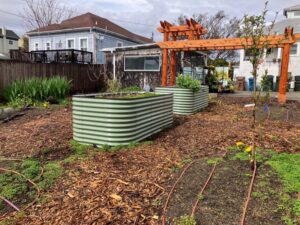 This homeowner attended our tours and was inspired to transform his yard! This brand new garden, designed by Michael Wedgley, is a unique opportunity to tour a stunning and sustainable backyard that showcases the beauty and abundance of permaculture. This eco-conscious backyard features a rainwater catchment system that can harvest up to 3,500 gallons per year, helping to restore the on-site water table, and providing an abundant source of water for this permaculture food forest.
This homeowner attended our tours and was inspired to transform his yard! This brand new garden, designed by Michael Wedgley, is a unique opportunity to tour a stunning and sustainable backyard that showcases the beauty and abundance of permaculture. This eco-conscious backyard features a rainwater catchment system that can harvest up to 3,500 gallons per year, helping to restore the on-site water table, and providing an abundant source of water for this permaculture food forest.
The carefully designed irrigation system utilizes drip irrigation, which not only lowers water usage but also promotes water conservation. Despite being only two months old, this new garden already boasts over 80 different species of perennial plants, many of which are edible. You’ll be amazed at the variety and richness of the plants that are flourishing in this environment.
Colibri Ochoa (Hummingbird Ochoa)
Front yard food forest garden has a laundry-to-landscape greywater system, a swale, repurposed logs to create planting areas and a variety of plants to provide food for people and pollinators. On the day of the tour there will be a laundry-to-landscape greywater education in Spanish and a translator on-site.
Sustainable Solano partnered with two other organizations to install this garden in 2021 and begin to provide resources in Spanish. Planting Justice partnered with Sustainable Solano on a Spanish-speaking installation. They offer permaculture services and also have an organic nursery in Oakland that sells rare and heirloom varieties. Club Stride translated an educational program about Patio Sostenibles and created a food forest video in Spanish, Entrevista de Patio Sostenible. Both organizations are doing incredible work to reduce inequities. Check out their websites to find out more on how to support their work.
Greywater Action’s Rahul will give a talk and tour of the laundry-to-landscape system at 2 pm in Spanish and 3 pm in English.
First Christian Church
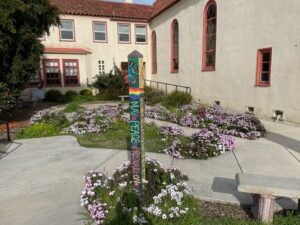 Two separate gardens, one is a peace garden with mostly flowers, cactus and trees and the other is the vegetable garden, called Johnson Ranch. The vegetable garden was revived through the Solano Gardens program. The food grown is donated to the local food pantries (Faith Food Fridays, Amador Hope Center, etc.).
Two separate gardens, one is a peace garden with mostly flowers, cactus and trees and the other is the vegetable garden, called Johnson Ranch. The vegetable garden was revived through the Solano Gardens program. The food grown is donated to the local food pantries (Faith Food Fridays, Amador Hope Center, etc.).
Enchanted Cottage Garden
Front yard lawn replaced in May 2017 with two swales, above-ground rainwater collection and a variety of fruit trees, grapes, herbs, and year-round pollinator plants mixed with annual vegetables. There is a path through it with seating for anyone who walks by. The food forest concept extends to the back garden. This yard has inspired several neighbors to transform their landscapes. Produce from the garden is used in the food forest keeper’s small home-based restaurant and they donate excess produce.
Loma Vista Farm
The Food Forest Garden is an extra special garden at the Farm. It provides a beautiful demonstration to the many thousands of people that visit each year on how to plant their own yard in a variety of fruit trees, perennial vegetables, herbs, native plants and pollinator plants. Volunteers will be available to show visitors the Food Forest Garden. The Farm will close promptly at 4 pm.
The tour will be on the same day as Loma Vista Farm’s annual Spring Open House, making it an extra special day to visit. The Farm event begins at 11 am and ends at 3 pm. Please come before 3 pm if you would like to enjoy both events.
As part of the Farm event there will be a plant sale in the greenhouse of natives, herbs, vegetables, and pollinator plants. The students from Loma Vista Environmental Science Academy produce these plants as part of their weekly farm science lessons.
For more information check out: Lomavistafarm.org.
Morningside Botanical Bounty
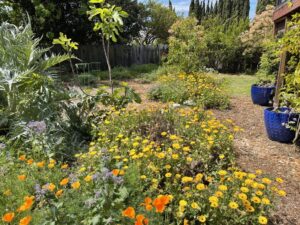 Morningside Botanical Bounty food forest was created as part of the Resilient Neighborhoods Program. This backyard garden has a laundry-to-landscape greywater system, fruit trees (pruned to keep them short and easy to harvest), swales, drip irrigation, bee-friendly plants, native plants and shade trees.
Morningside Botanical Bounty food forest was created as part of the Resilient Neighborhoods Program. This backyard garden has a laundry-to-landscape greywater system, fruit trees (pruned to keep them short and easy to harvest), swales, drip irrigation, bee-friendly plants, native plants and shade trees.
Native plant information will be available.
Pollinator Pathway
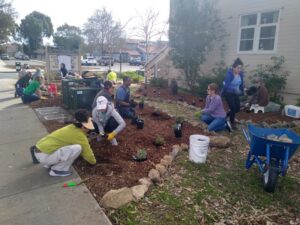 Pollinator food forest garden filled with a variety of California native plants that support the habitat of butterflies, bees, moths, wasps, hummingbirds and so much more. This garden was just installed in February 2023 as a collaboration with a variety of organizations including Vallejo People’s Garden, Vallejo Project, Solano Resource Conservation District and Monarch Milkweed Project. Alanna Mirror wrote three songs inspired by the installation, featured in her Pollinator Pathway Lawn Transformation Mini Series!
Pollinator food forest garden filled with a variety of California native plants that support the habitat of butterflies, bees, moths, wasps, hummingbirds and so much more. This garden was just installed in February 2023 as a collaboration with a variety of organizations including Vallejo People’s Garden, Vallejo Project, Solano Resource Conservation District and Monarch Milkweed Project. Alanna Mirror wrote three songs inspired by the installation, featured in her Pollinator Pathway Lawn Transformation Mini Series!
Designer John Davenport of Cali Ground Troops will be at the site from 12-4 pm to tour and educate on how this 3,000 square foot lawn was converted into a native pollinator garden. The tour coincides with Vallejo People’s Garden Earth Day Celebration, 11 am-4 pm, which will include food trucks, live music, artisans, hand crafted goods, education, free seeds and garden classes.
Terraza Dominicana (St. Patrick-St. Vincent Catholic High School)
SPSV Food Forest comprises six planting guilds, each with a central tree and underplanting on a steep hillside. It is used as a living laboratory for students to explore soil health, water conservation and pollination. The food forest highlights design features to address erosion control as well as techniques using repurposed materials for terracing a hillside. The garden space also includes a beautiful meditation labyrinth for reflection and contemplation.
Students from SPSV’s Urban Farmers club will be sponsoring a plant sale, and Scott Dodson, the owner of Bee Tribe Honey Farms, will be educating about bees and hive maintenance and selling his raw honey.
Vallejo Unity Garden (Vallejo Project)
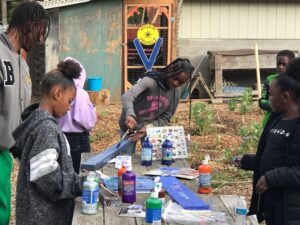 Vallejo Project’s Unity Garden initiative restored an abandoned lot that was once filled with sand and garbage and turned it into a multi-level food forest with internationally influenced farming techniques and 10 chickens. This garden is focused on urban agriculture.
Vallejo Project’s Unity Garden initiative restored an abandoned lot that was once filled with sand and garbage and turned it into a multi-level food forest with internationally influenced farming techniques and 10 chickens. This garden is focused on urban agriculture.
There will be seeds, plants or art from the garden for sale.
Vallejo Project imagines a Vallejo strengthened by new generations of youth and young adults who are inspired to give back to their community as role models, advocates, entrepreneurs, and leaders; who are able to efficiently articulate and implement solutions to challenges in the community based on their learned experience and knowledge gained through youth development programs.
We are incredibly grateful for the generous support of our funders. The first seven food forest gardens were made possible through funding from the Benicia Sustainability Commission; the Solano County Water Agency continues to support the Sustainable Backyard Program throughout the county. Solano Sustainable Backyard Program short videos: Waterwise and Building Gardens and Community. Occasionally we combine funding from other programs to make larger projects possible.



